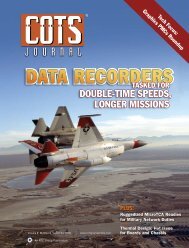Inrush Current Control Technology Boosts Power Converter Reliability
Inrush Current Control Technology Boosts Power Converter Reliability
Inrush Current Control Technology Boosts Power Converter Reliability
You also want an ePaper? Increase the reach of your titles
YUMPU automatically turns print PDFs into web optimized ePapers that Google loves.
Tech Recon<br />
Managing and Processing the ISR Data Deluge<br />
GPGPU <strong>Technology</strong> Eases<br />
Persistent Imaging Processing<br />
Challenges<br />
For the data-intensive processing needs of persistent image processing, GPGPUs<br />
can outperform CPUs at real-time parallel data stream computation.<br />
Anne Mascarin, Solutions Marketing Manager<br />
Mercury Computer Systems<br />
Although used previously in conventional<br />
warfare applications, persistent<br />
imaging is a major new advancement<br />
in the war against terror. Radar,<br />
electro-optical (EO), infrared (IR), signals<br />
intelligence (SIGINT) and hyper-spectral<br />
are among the sensor system modalities<br />
that can be used for this purpose. The ability<br />
to collect, process and compare outputs<br />
from these sensor systems captured from<br />
aboard a moving platform such as an Unmanned<br />
Aerial Vehicle (UAV), or from a<br />
stationary airborne platform such as an<br />
aerostat, can provide the warfighter with<br />
invaluable situational awareness.<br />
Since today’s modern sensors can<br />
gather so much data during long collection<br />
missions, extracting the real-time<br />
actionable information from the data<br />
and storing it for later forensic analysis<br />
is a challenging task (Figure 1). There are<br />
some key technologies worth exploring<br />
for addressing this challenge using highperformance<br />
embedded computing to<br />
process and reduce the data from current<br />
and next-generation sensors.<br />
Persistent Imaging Processing<br />
The derivation of real-time actionable<br />
information from sensor data is a<br />
[ 44 ] COTS Journal November 2011<br />
Figure 1<br />
Today’s modern sensors can gather so much data during long collection missions that<br />
extracting the real-time actionable information from the data, and storing it for later<br />
forensic analysis, is a challenge. A Global Hawk UAV shown here gets all pre-flight checks<br />
accomplished from maintenance technicians before a mission.<br />
compute-intensive, real-time operation<br />
that requires SWaP (Size, Weight and<br />
<strong>Power</strong>)—optimized, ultra-high speed,<br />
real-time processing power. Traditionally<br />
used only in gaming, GPGPUs are<br />
performance powerhouses in terms of<br />
performance and SWaP optimization.<br />
In many instances, GPGPUs can outperform<br />
CPUs. GPGPUs excel at performing<br />
mathematical operations such as image<br />
processing on parallel data streams, because<br />
GPGPUs are actually highly par-






